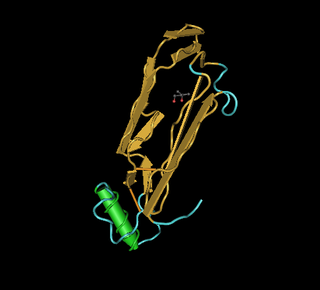BMP2
| Proteína morfogénica ósea 2 | ||||
|---|---|---|---|---|
 Estructura tridimensional de la proteína BMP2. | ||||
| Estructuras disponibles | ||||
| PDB |
Lista de códigos PDB 1es7
| |||
| Identificadores | ||||
| Símbolos | BMP2 (HGNC: 1069) BMP2A | |||
| Identificadores externos | ||||
| Locus | Cr. 20 p12.3 | |||
| Ortólogos | ||||
| Especies |
| |||
| Entrez |
| |||
| UniProt |
| |||
| RefSeq (ARNm) |
| |||
La proteína morfogénica ósea 2 (BMP2) es un miembro de la superfamilia de proteínas TGF-beta.[1]
Función
[editar]BMP2, al igual que otras proteínas morfogénicas óseas,[2] juega un importante papel en el desarrollo del hueso y el cartílago. Está implicada en la ruta de señalización de hedgehog y de TGF-beta, así como en la interacción citoquina-receptor de citoquina. También parece estar implicada en diferenciación de células cardíacas y en la transición epitelio-mesénquima.
BMP2 y BMP7 son BMPs osteogénicas e inducen fuertemente la diferenciación de los osteoblastos en diversos tipos celulares.[3]
Usos médicos
[editar]La proteína BMP2 ha demostrado ser capaz de estimular la producción de hueso, de modo que actualmente se utiliza la BMP2 humana recombinante (rhBMP2) en cirugía ortopédica y traumatología en Estados Unidos.[4] La implantación de BMP2 en una esponja de colágeno induce la formación de nuevo hueso y puede ser utilizado como tratamiento de ciertos defectos óseos.[5]
BMP2 también es utilizada en el campo de la odontología. La cirugía oral se ha visto beneficiada particularmente con la comercialización de esta proteína.[6][7][8] El uso de BMP2 en esponjas absorbibles de colágeno ha permitido mantener fusiones espinales de los discos intervertebrales, reduciendo los costos de las intervenciones y el dolor sufrido por los pacientes con enfermedad degenerativa de los discos lumbares.[9] BMP2 parece aumentar la velocidad de fusión después de una artrodesis espinal tanto en modelos animales como en humanos.[10]
Interacciones
[editar]La proteína BMP2 ha demostrado ser capaz de interaccionar con:
Referencias
[editar]- ↑ Sampath TK, Coughlin JE, Whetstone RM, Banach D, Corbett C, Ridge RJ, Ozkaynak E, Oppermann H, Rueger DC (5 de agosto de 1990). «Bovine osteogenic protein is composed of dimers of OP-1 and BMP-2A, two members of the transforming growth factor-beta superfamily». J. Biol. Chem. 265 (22): 13198-205. PMID 2376592. Archivado desde el original el 9 de mayo de 2005. Consultado el 18 de febrero de 2010.
- ↑ Chen D, Zhao M, Mundy GR (diciembre de 2004). «Bone morphogenetic proteins». Growth Factors 22 (4): 233-41. PMID 15621726. doi:10.1080/08977190412331279890.
- ↑ Marie PJ, Debiais F, Haÿ E (2002). «Regulation of human cranial osteoblast phenotype by FGF-2, FGFR-2 and BMP-2 signaling». Histol. Histopathol. 17 (3): 877-85. PMID 12168799.
- ↑ Khan SN, Lane JM (mayo de 2004). «The use of recombinant human bone morphogenetic protein-2 (rhBMP-2) in orthopaedic applications». Expert Opin Biol Ther 4 (5): 741-8. PMID 15155165. doi:10.1517/14712598.4.5.741.
- ↑ Geiger M, Li RH, Friess W (noviembre de 2003). «Collagen sponges for bone regeneration with rhBMP-2». Adv. Drug Deliv. Rev. 55 (12): 1613-29. PMID 14623404. doi:10.1016/j.addr.2003.08.010.
- ↑ Allegrini S, Yoshimoto M, Salles MB, König B (febrero de 2004). «Bone regeneration in rabbit sinus lifting associated with bovine BMP». J. Biomed. Mater. Res. Part B Appl. Biomater. 68 (2): 127-31. PMID 14737759. doi:10.1002/jbm.b.20006.
- ↑ Schlegel KA, Thorwarth M, Plesinac A, Wiltfang J, Rupprecht S (diciembre de 2006). «Expression of bone matrix proteins during the osseus healing of topical conditioned implants: an experimental study». Clin Oral Implants Res 17 (6): 666-72. PMID 17092225. doi:10.1111/j.1600-0501.2006.01214.x.
- ↑ Schliephake H, Aref A, Scharnweber D, Bierbaum S, Roessler S, Sewing A (octubre de 2005). «Effect of immobilized bone morphogenic protein 2 coating of titanium implants on peri-implant bone formation». Clin Oral Implants Res 16 (5): 563-9. PMID 16164462. doi:10.1111/j.1600-0501.2005.01143.x.
- ↑ Burkus JK, Gornet MF, Schuler TC, Kleeman TJ, Zdeblick TA (mayo de 2009). «Six-year outcomes of anterior lumbar interbody arthrodesis with use of interbody fusion cages and recombinant human bone morphogenetic protein-2». J Bone Joint Surg Am 91 (5): 1181-9. PMID 19411467. doi:10.2106/JBJS.G.01485.
- ↑ Subach BR, Haid RW, Rodts GE, Kaiser MG (2001). «Bone morphogenetic protein in spinal fusion: overview and clinical update». Neurosurg Focus 10 (4): E3. PMID 16732630.
- ↑ Nickel, J; Dreyer M K, Kirsch T, Sebald W (2001). «The crystal structure of the BMP-2:BMPR-IA complex and the generation of BMP-2 antagonists». The Journal of bone and joint surgery. American volume (United States). 83-A Suppl 1 (Pt 1): S7-14. ISSN 0021-9355. PMID 11263668.
- ↑ Kirsch, T; Nickel J; Sebald W (Feb. de 2000). «Isolation of recombinant BMP receptor IA ectodomain and its 2:1 complex with BMP-2». FEBS Lett. (NETHERLANDS) 468 (2-3): 215-9. ISSN 0014-5793. PMID 10692589. doi:10.1016/S0014-5793(00)01214-X.
- ↑ Kirsch, T; Nickel J; Sebald W (Jul. de 2000). «BMP-2 antagonists emerge from alterations in the low-affinity binding epitope for receptor BMPR-II». EMBO J. (ENGLAND) 19 (13): 3314-24. ISSN 0261-4189. PMC 313944. PMID 10880444. doi:10.1093/emboj/19.13.3314.
- ↑ Gilboa, L; Nohe A, Geissendörfer T, Sebald W, Henis Y I, Knaus P (Mar. de 2000). «Bone morphogenetic protein receptor complexes on the surface of live cells: a new oligomerization mode for serine/threonine kinase receptors». Mol. Biol. Cell (UNITED STATES) 11 (3): 1023-35. ISSN 1059-1524. PMC 14828. PMID 10712517.